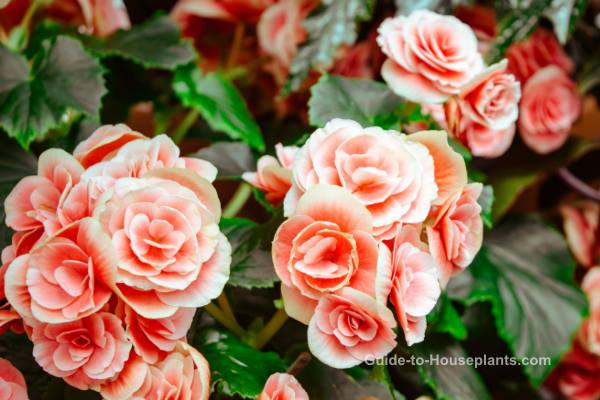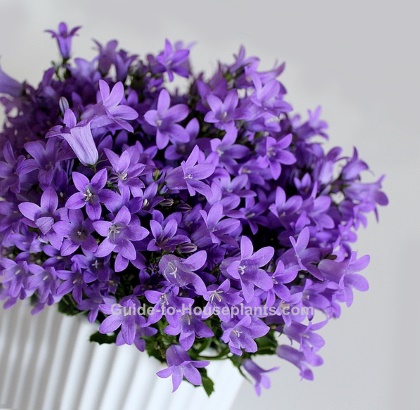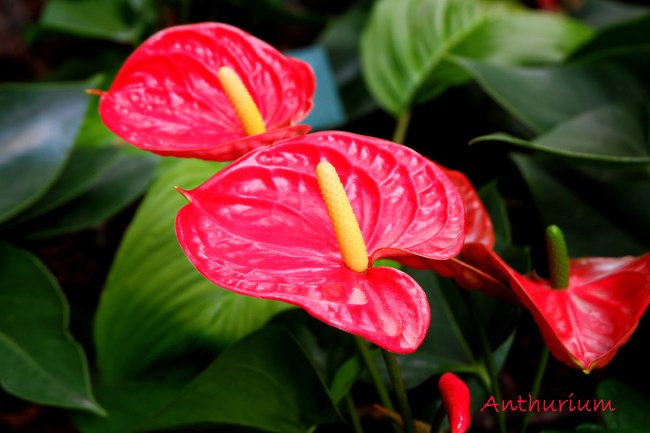Flamingo Flower
Botanical Name: Anthurium scherzerianum
Flamingo Flower is well-known by its red, oval spathes, each with a twisted, orange spadix covered densely with its tiny, true flowers. Spathes last for up to 8 weeks.
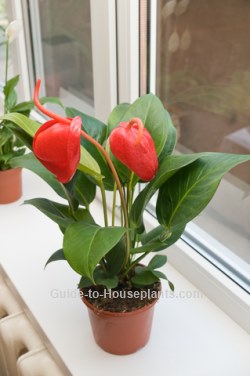
Get to Know Flamingo Flower
Large pointed, dark-green leaves grow up to 7 in (18 cm) long and surround the upright flower stems. Anthurium leaves are poisonous. They contain calcium oxalate crystals that can cause severe burning in the mouth. Keep your flamingo plant away from pets who may play with or chew on its foliage. It's also a good idea to wear gloves when handling anthurium plant to avoid skin irritation.
You'll find anthurium growing in warm, tropical regions. This Central America native prefers bright light, moist soil and moist air. Newer cultivars are less fussy about humidity and many hybrids are more lush, compact, and will bloom nearly year-round, taking a break in winter.
Flamingo Flower Problems, Answers and How-tos
Repot a young plant in spring when its roots have filled the container. Set the plant high so that the crown sits above the soil line. If roots appear at the surface between repottings, cover them with potting mix. Move your anthurium plant to a pot only 1 size larger. Be sure to use a pot with a drainage hole. Good drainage is essential to prevent root rot.
Keep leaves clean. Anthurium leaves are naturally glossy. Gently wipe them with a damp cloth, or spray with a fine mist of room-temperature water, to keep them dust-free. Avoid leaving water drops on the leaves because it may cause a fungus that appears as dry, brown spots that need to be treated with a fungicide.
Something bugging your plant? Peaty potting mixes that are kept moist often attract fungus gnats. They look like tiny, black flies that crawl on the surface of the potting medium. You can prevent them by allowing the top surface of the medium to dry out before watering again.
Yellow leaves are typically caused by overwatering. They can also indicate the plant is too cold; remember, this tropical native likes the same warm temperatures that we do. Yellow leaves with brown tips may be a sign of too much fertilizer. Brown leaf tips usually are caused by dry air; raise the humidity around your plant.
Few blooms? As I said before, newer cultivars are loaded with colorful spathes most of the year. If your Flamingo Flower isn't flowering, it is either not getting enough sunlight, or not enough phosphorous. (See "light" and "fertilizer" tips below.)
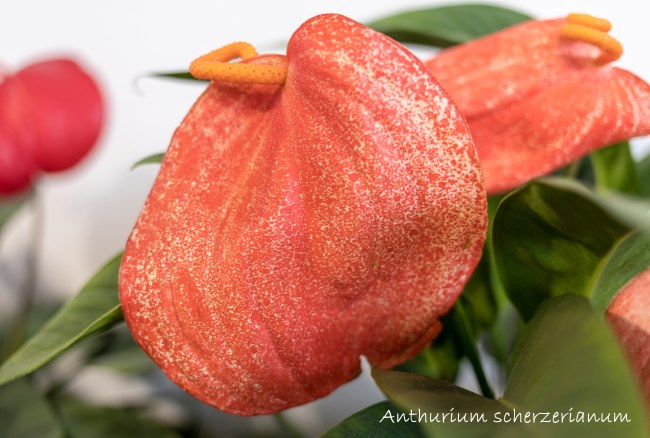 Anthurium scherzerianum 'Rothschildeanum' is a captivating spotted cultivar. Photo © Wieslaw Jarek
Anthurium scherzerianum 'Rothschildeanum' is a captivating spotted cultivar. Photo © Wieslaw JarekFlamingo Flower Buying Tips
You can order these tropical flowers online from flower delivery sites and nurseries. Many named cultivars are available to choose from, including some with dark red, pink or white spathes. 'Rothschildeanum' has a red or orange spotted spathe. 'Wardii' has a dark red spathe.
This is a beautiful, lush tropical plant even when not in bloom. Give your anthurium growing conditions like its native habitat, and you'll enjoy it for several years.
Flamingo Flower Care Tips
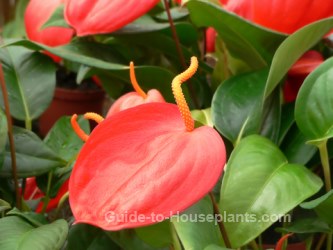
Origin: Costa Rica
Height: 12-18 inches (30-45 cm). Flower stalks may need staking.
Light: Bright light, but no direct sun. Plants that don't bloom aren't getting enough light. Move the plant near a window where it gets bright light, out of direct sun.
Water: Keep soil evenly moist in spring and summer, while plant is actively growing. Water less often in fall and winter, but don't allow potting medium to dry out. Yellow leaves may be a sign of overwatering.
Humidity: Moderate to high. Use a humidity tray or a cool-mist room humidifier if the relative humidity drops below 50%.
Temperature: Average to warm 65-75°F/18-24°C. Flamingo Flower grows best with even temperatures year-round. Exposing it to temperatures below 60°F/10°C can cause its leaves to turn yellow. It doesn't like drafts either; it's a good idea to keep Anthurium away from air vents.
Soil: Peat moss based potting mix with added perlite. African violet potting mix is ideal.
Fertilizer: Feed every 2 weeks in spring and summer with a high-phosphorus water-soluble fertilizer, diluted by half.
Propagation: Divide crowded clumps when repotting, and pot them separately in small pots. Spring is the best time to start new plants. High humidity will give them a good start. Your young plants should begin flowering in about a year.
